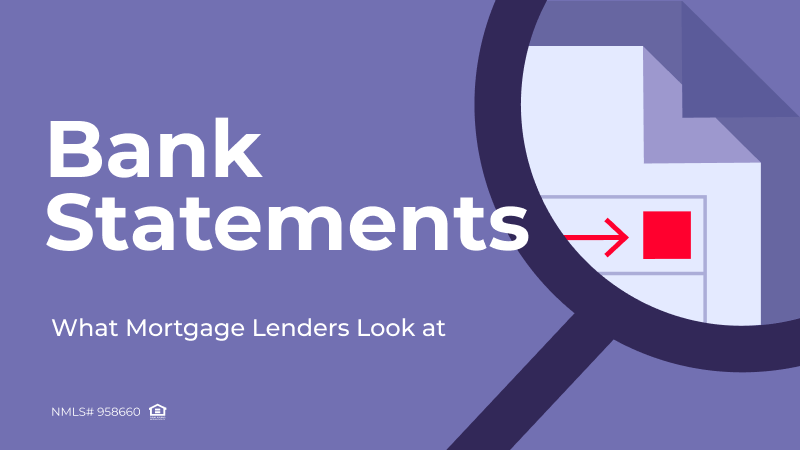
While bank statements may seem like mere pieces of paper, they are much more than that. They’re a financial snapshot, a story about the borrower’s money coming in and going out. For mortgage lenders, these statements are like a detective story. They’re looking for clues about your client’s financial health, their income, their spending habits, and whether they can handle a mortgage. But what do mortgage lenders look for on bank statements?
It’s not just about handing over paperwork. It’s about helping your clients tell the right financial story. When you know what mortgage lenders look for on bank statements, you can spot potential problems early, explain things clearly to your clients, and even suggest ways to improve their financial picture before they apply.
But what do mortgage lenders look for on bank statements exactly?
In this article, we’ll cover the key elements that are reviewed on bank statements during the loan application process, key requirements, and insights on how to help borrowers prepare.
Why Lenders Require Bank Statements
So why do lenders care so much about your clients’ bank statements? They are in the business of lending money, but they are also in the business of managing risk. When they give someone a mortgage, they’re betting that person will pay it back. To make that bet, they need information. That’s where bank statements come in. These statements are a financial window into the borrower’s life. Lenders use them to get a clear picture of their income, their expenses, and their overall financial situation.

Bank Statement:
Empower your clients!
- The perfect fit for self-employed borrowers
- Up to 90% CLTV, loans up to $4M
- Low FICO options (from 599)
Lenders also check for any red flags that might indicate financial trouble, looking for evidence that a person can handle the responsibility of a mortgage. It’s like putting together a jigsaw puzzle. Each piece of the bank statement helps complete the financial picture. Lenders want to see financial consistency and responsible money management. This helps them feel confident that the borrower can handle the financial commitment of a mortgage.
After all, it’s all about protecting the lender’s investment. Only by carefully reviewing bank statements can they make decisions about who to lend money to and how much to lend.
Key Elements Lenders Look For
There are four main elements that mortgage lenders look for on bank statements to get a clear picture of a potential borrower’s financial situation: their income, their expenses, the overall stability of their finances, and the source of their deposits. Let’s take a closer look at each of these elements.
Income
First, lenders want to verify the borrower’s income. They’ll look for regular deposits that match your client’s pay stubs. If they have other sources of income, such as rental properties or investments, they’ll want to see proof of those as well. Your client needs to show a consistent income stream to demonstrate their ability to afford a mortgage.
Expenses
Second, lenders look at the borrower’s spending habits. They want to see if they are responsible with their money. Are they saving? Do they pay their bills on time? Do they have a history of large unexplained expenses? These details help them assess the borrower’s ability to manage a monthly mortgage payment in addition to their current expenses.
Account Stability
Next, lenders look at the overall stability of the borrower’s account. A history of overdrafts or unexplained large deposits can raise red flags. They want to see a consistent account balance and a responsible financial history.
Properly Sourced Assets
Finally, another crucial thing to remember is the importance of “sourced and seasoned” funds. This means that lenders need to know where your client’s money came from and that it’s been in their account for a certain amount of time. It’s like proving they’ve been a good financial steward over time.
If you understand these four key elements, you can help your clients prepare their statements for the best possible result.
Specific Red Flags for Lenders
When it comes to mortgage underwriting, lenders are trained to spot certain red flags on bank statements. These are signs that might indicate potential financial instability or even fraudulent activity. Mortgage brokers must be aware of these red flags to help their clients avoid delays or rejections.
One common red flag is bounced checks or insufficient funds (NSFs). These show a pattern of poor financial management and raise concerns about the borrower’s ability to handle regular payments like a mortgage.
Another red flag is large, undocumented deposits. As we’ve mentioned before, lenders want to know where your client’s money comes from. Large sums of cash or unexplained transfers can trigger extra scrutiny. A borrower needs to have clear documentation for all deposits.
Finally, unexplained payments to individuals or undisclosed accounts are a big red flag. Lenders need to see a clear picture of where a borrower’s money is going. Any hidden expenses or payments can raise questions about financial responsibility.
Understanding these red flags is critical for mortgage brokers. You can help your clients prepare their bank statements by addressing these issues upfront. By being proactive, you can increase the chances of a loan approval.
Documentation Requirements
Enhanced Broker Portal
that makes your job easier
- All operations at your fingertips
- Easy-to-use intuitive interface
- Integrated AI technology
To ensure a smooth loan process, borrowers should provide complete bank statements for the past two or three months. This includes all pages, even if blank, to avoid any potential gaps in information. The statements should display the borrower’s name, the bank’s name, the account number, and a detailed record of all transactions, including deposits, withdrawals, and fees.
In some cases, lenders may request additional documentation to verify the source of large or unusual deposits. For example, if a large amount appears to be a gift, a gift letter from the donor may be necessary. Similarly, large deposits related to employment, such as bonuses or commissions, may require verification from the employer. Other potential triggers for extra paperwork include proceeds from the sale of assets, loans, investments, tax refunds, or legal settlements. Additionally, the lender will want to see that the money has been in your client’s account for a specific period, usually around 60 days. This is to ensure that the funds are available for the mortgage.
Your client needs to be prepared for these extra requests. Having all the necessary documentation ready can speed up the mortgage process significantly.
Preparing Your Clients for the Bank Statement Review
Setting clear expectations about bank statements is essential to a smooth mortgage process. Your clients should understand that these documents provide the lender with a financial snapshot that is critical in making a lending decision.
To prepare your clients, emphasize the importance of accurate and complete bank statements. Encourage them to review their statements before submitting them to identify any potential issues. Explain that discrepancies or missing information can lead to delays or requests for additional documentation.
Maintaining a clean financial history is crucial. Advise clients to avoid overdrafts, bounced checks, NSFs, and unexplained large deposits. Encourage them to pay bills on time and keep their accounts balanced. A history of responsible financial management is a strong asset in the mortgage application process.
Anticipate potential requests for additional documentation. Inform clients that lenders may require pay stubs, W-2s, or tax returns to verify income and employment. Explain that this is a standard procedure and that providing these documents promptly is essential.
Building trust and open communication with your clients is key. Reassure them that you’ll guide them through the process, explaining each step and addressing any concerns. By providing clear and concise information, you can alleviate their anxiety and ensure a smoother mortgage experience.
Remember, a well-prepared client is more likely to have a successful mortgage application.
Conclusion
Get the ADvantage
with our loyalty program
Earn and redeem points for valuable benefits for you and your clients
Unlock RewardsBank statements are more than just financial records; they’re the foundation upon which mortgage decisions are built. As a mortgage broker, your ability to interpret these documents is essential to guiding clients through the often-complex mortgage application process. By knowing what mortgage lenders look for on bank statements, recognizing potential red flags, and effectively communicating with clients, you can significantly increase their chances of getting approved for a loan.
Remember, your role goes beyond processing paperwork. You are a financial advisor, problem solver, and trusted advocate. By explaining statements to your clients, you can not only streamline the mortgage process but also build stronger relationships.
Want to learn more about mortgage lending? Subscribe to the AD Mortgage Blog for valuable insights, industry updates, and practical tips to help you excel in your business.


